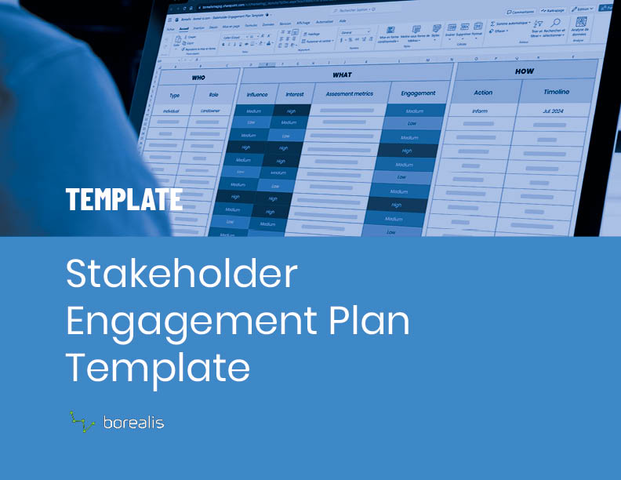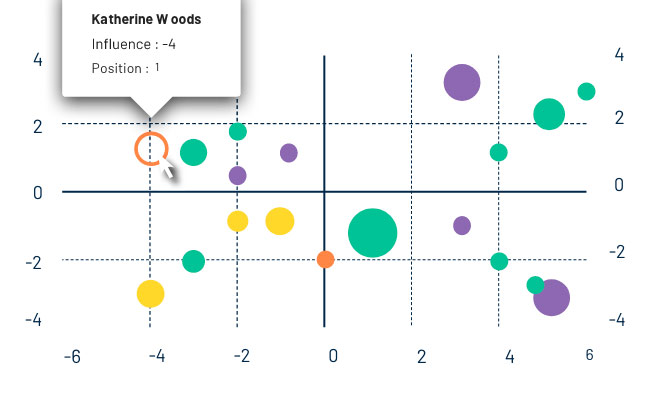How to handle difficult relationships with demanding stakeholders?
Stakeholder management is a key part of any project – particularly large-scale ones. It’s a complex exercise that involves dealing with a multitude of people, often with differing interests. Many project stakeholders will generally collaborate positively because they either see the project’s potential or have a vested interest in its success. Some stakeholder relationships, however, can be a little more challenging. Knowing how to deal with difficult stakeholders is an important aspect of a manager’s job.
There are several reasons why some stakeholders may adopt a hostile attitude toward a project. They may be poorly informed about the project or perhaps they’re being influenced by a third party. Or maybe they have had bad experiences in a similar context or were disrespected in past communications (lack of tact, the wrong language used, etc.). Some problematic stakeholders may simply be having a hard time adapting to the changes being brought about by the project.
Whatever the reason for poor collaboration from certain stakeholders, project managers and community relations agents need to know how to handle difficult stakeholders. To do that, they need to possess the right skills and tools. They need to be able to identify difficult stakeholders but also understand the root cause of this negativity. Most importantly, they need to be able to address their concerns effectively.
This takes strong interpersonal skills. There are also technological tools that can help.
What is a difficult stakeholder?
Indifferent stakeholders
Stakeholders may be indifferent to a project if it has minimal consequences on their activities and they feel they have better things to do than get involved. Indifferent stakeholders may voluntarily withdraw from engagement activities, which could have long-term repercussions on the project. A stakeholder may also be neutral toward a project, but the project manager would prefer them to be an ally or even a promoter.
Passive-aggressive stakeholders
Passive-aggressive stakeholders may verbally express their commitment to the project and assure project managers of their support, but at the same time take every opportunity to hinder its smooth progress. They may oppose other stakeholders and create disruptions that end up costing time and money.
Hostile stakeholders
Hostile stakeholders are against the project and often aren’t afraid to say so loud and clear. Some hostile stakeholders will even go to extreme means to openly sabotage the project.
These different types of difficult stakeholders may express their disengagement or opposition in various ways. For example:
- An environmentalist group may hold multiple protests against a mining project.
- A company may try to block a project for fear of losing customers.
- A senior executive may refuse to change the working method required to carry out a project.
- A department manager may exhaust employees with unrealistic demands due to pressure from company executives to deliver quick results.
How to identify difficult stakeholders?
Project managers who prioritize best stakeholder management practices from the project onset are usually able to identify difficult stakeholders naturally. Every project should therefore start with a thorough analysis of project stakeholders.
Census and data collection
This first step involves listing all project stakeholders to create a stakeholder register. This database should include all individuals, groups, and organizations that could influence the project’s progress or be impacted by it.
During this step, relevant information about each stakeholder or group is gathered to help determine the amount of engagement that will be required. This information includes each stakeholder’s level of interest, influence, and knowledge of the project, along with their degree of commitment toward it.
As part of this exercise, you can identify who your key stakeholders are and prepare a list of benefits that each individual or group stands to gain from getting involved in the project and supporting its success. These are useful arguments to have on hand during any stakeholder exchange, but especially when you’re dealing with difficult stakeholder relationships.

Creating a solid stakeholder engagement plan is crucial for effective project management.
Analysis and ranking
To gain an even clearer picture of your stakeholder landscape, you can organize stakeholders in an influence/interest grid to gain a snapshot of each stakeholder and group in your register.
This mapping makes it extremely easy to visualize each stakeholder’s stance and relationship with the project – a good way to quickly identify those who risk delaying or jeopardizing the project. In turn, this makes it much easier to determine which stakeholders merit particular engagement efforts. It also provides valuable information on stakeholders’ concerns, including those that could lead to “difficult” behaviors to manage.
Borealis software for stakeholder management offers features – such as a built-in mapping tool – that adapt to any type of stakeholder relationship, no matter how smooth or difficult. It also lets you organize and store all your stakeholder data in a single, central location so that this data can be easily consulted and analyzed when needed.

How to deal with difficult stakeholders?
All managers need to know how to handle difficult stakeholders. Adopting mature and respectful behavior will help. For example:
Don’t take it personally
Disgruntled stakeholders react to situations that trigger a negative emotional response. A manager who feels personally attacked when dealing with difficult stakeholders will be unable to distance themselves sufficiently to effectively search for the root causes of this stakeholder dissatisfaction.
Exercise self-control
In the same vein, managers who exercise self-control over their words, actions, and emotions will help minimize outbursts that can occur during tense exchanges.
Use tact and honesty
While it’s crucial to remain polite and diplomatic when dealing with difficult stakeholders, it’s just as important to be honest – both in terms of expectations and possible compromises.
Managers who embrace the above behavior can positively impact relationships with difficult stakeholders. But the most important factor always remains communication.
Clear, constant, and respectful communication
Share information
After you have analyzed your stakeholders and made initial contact with them, it’s crucial to share all information that could be of interest or concern to them. Clear and transparent communication with all stakeholders is always a must. But when it comes to more problematic stakeholders, having a good communication plan is especially important. And this is precisely where a software tool like Borealis is particularly helpful.
In Borealis, each stakeholder’s file includes all the information you need to build a relationship of trust. In addition to basic stakeholder information such as contact details, each file includes fields that provide valuable information about:
- The stakeholder’s position on the project
- The type of relationship maintained with that stakeholder
- The number and type of communications involving that stakeholder – including their content
- The stakeholder’s grievances and concerns
- The stakeholder’s level of commitment
- Which communications the stakeholder should receive
- How these communications should be delivered to the stakeholder
Using a stakeholder relationship management tool such as Borealis, makes this information easily accessible at all times to anyone who needs it. It allows you to prepare for an upcoming discussion, meeting, or engagement activity with full knowledge of the facts. From the stakeholder’s perspective, this shows respect and a desire to engage in open and constructive dialogue.
Using the stakeholder’s preferred language and means of communication (emails, phone calls, face-to-face meetings) is another sign of respect that will help when dealing with difficult stakeholders,
Just as important? Holding regular communications with stakeholders and responding promptly to their requests or questions. Rapid responses – even negative ones – will always strengthen trust.
To simplify and streamline communication tasks, Borealis software comes with a mobile app, add-ons for Outlook and Gmail, and SMS messaging.
Listen
Providing your stakeholders with information about the project is essential. But so is listening to your stakeholders, particularly problematic stakeholders. Above all, managers need to have good listening skills. Active listening will reveal the main concerns and motivations behind the actions of difficult stakeholders. After all, to handle a problem, you first need to be aware of it.
When dealing with a close-lipped stakeholder, ask questions to get the conversation going. Use open-ended questions to allow the stakeholder to explain the source of their discomfort. Invite the stakeholder to participate in coming up with possible solutions. For example, you can ask: “What could we do to work better together?” or “How we can improve the project?”
Another good way to “listen” to stakeholders? Provide stakeholders with a secure and easily accessible virtual space where they can share their complaints and comments, even anonymously. Borealis software comes with an issue and complaint management module to make collecting, recording, and analyzing stakeholder feedback easy.
All this questioning and dialogue serve a clear purpose: to understand the concerns of stakeholders so that you can adequately respond to them.
Above we looked at some of the possible root causes of negative stakeholder behavior. Other root causes can include skepticism, dissatisfaction, misunderstanding, or even a lack of availability or rapport.
Whatever the reason, if you know how to manage difficult stakeholders, you can dig deeper to engage in fruitful discussions and resolve conflict situations.
Other tips for gaining the support of demanding stakeholders
In an article written from his own experience, product manager and author Aninda Baruah offers a few more tips for turning a hostile stakeholder into a project supporter.
Take action and demonstrate success
Baruah advises going beyond kind words. He recommends taking action to effectively resolve issues. A hesitant stakeholder might come around if they see that you backed up your promises to other stakeholders with concrete actions. Along the same vein, a difficult stakeholder might be swayed if you can show that you have already successfully implemented an identical or similar project with positive outcomes in the past.
Rely on statistics
Baruah recommends using statistics “wherever possible” to correct misconceptions – such as when it comes to demonstrating a method’s effectiveness or a team’s performance.
Here again, Borealis software can be extremely useful, thanks to its integrated report creation tool.
Have the right management tools to be better prepared
Difficult individuals or groups will always be part of the stakeholder landscape in large-scale projects. This is notably due to environmental and social justice issues, which have now become an inherent part of such endeavors. As a manager, it’s important to be prepared to face these delicate situations.
This preparation does not need to be done “outside” of routine stakeholder management activities. By implementing good stakeholder management practices from the onset of the project – and supporting these practices with the right tools (data collection, thorough analysis, adequate communication, use of specialized software, etc.) – managers can be well equipped to successfully manage difficult stakeholders and problematic negotiations.
The key takeaway is this: Start with good stakeholder management practices. Support them with the right stakeholder management tools. Then carry out your stakeholder activities with diplomacy, respect, and honesty – qualities that have proven their merit time and time again.

Now that you know better how to deal with difficult stakeholders, you’re ready to build your communications strategy. Follow our step-by-step guide to creating an effective engagement plan.





